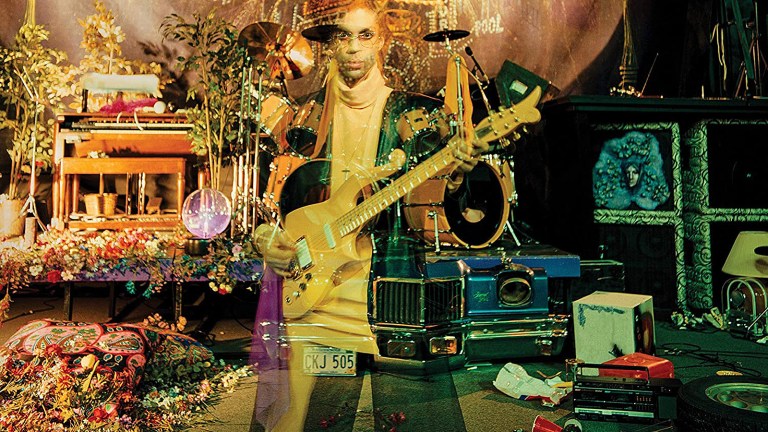Ready Player Two: The Sequel’s Best Easter Eggs & References
Pop culture mashups are the winners in Ernest Cline’s new nostalgia-fest novel. Here are the Easter eggs that worked best in Ready Player Two.

This piece contains spoilers for Ready Player Two.
When Ernest Cline published Ready Player One in 2011, its exhaustive array of Easter eggs were literally built into the worldbuilding—seemingly one pop culture name-drop per pixel that made up the digital OASIS, per the fierce 1980s nostalgia that creator James Donovan Halliday possessed for the most formative decade of his adolescence. And once the billionaire inventor revealed the Easter egg hunt for his fortune, it made perfect sense that the 2040s generation of gunters would immerse themselves in the same references, placing themselves into Halliday’s mindset to inherit his treasure.
Almost a decade later, those ’80s references are more exhausting in Ready Player Two—like when Wade rattles off his vintage morning routine basically cosplaying as Marty McFly, down to getting woken up by Huey Lewis and the News’ “Back in Time” via a Panasonic RC-6015 flip-clock radio. Whereas the Wade of Ready Player One enthusiastically logged onto the OASIS by quoting The Last Starfighter, the sequel’s gunter-turned-billionaire seems burnt out. He takes no joy in playing at a fictional character’s life instead of trying to improve his own.
Similarly, if Twitter reactions are any indication, readers of Ready Player Two are already finding the dense ’80s shout-outs to be more white noise than fun tidbits to be caught and noticed. It’s the same trick, but it loses its efficacy once you’ve seen behind the curtain.
That said, there are a handful of Easter eggs that break through the static. Because what’s the best way to make two familiar things new again? You mash them up.
Seven Shards for the Siren’s Soul
In some ways, it feels as if the sequel is retreading familiar ground, not quite copying Ready Player One’s Easter egg hunt but certainly building a seven-part quest around solving pop culture riddles. What somewhat redeems the narrative choice is a slightly different take on Easter eggs: not an exhaustive ’80s Wikipedia entry, but the personal Easter eggs of one woman’s life.
That woman is Kira Underwood, wife of OASIS co-founder Ogden Morrow, but also the unrequited love of James Donovan Halliday. As young adults, their Dungeons & Dragons campaigns eventually transformed into the creation of Gregarious Games and, ultimately, Gregarious Simulation Systems and the OASIS. But when Kira died young, both men mourned her… but only one tried to bring her back.
This time around, the prize is not Halliday’s fortune, but Kira’s “soul”—or, at least, a digital copy of her consciousness that Halliday copied without her knowledge or permission. Each Shard references a key point in Kira’s life, plenty of which overlap with Halliday’s ’80s obsession, as Kira met the two boys in 1988—in the middle of playing Sega Ninja, in fact. That’s the trial for the Second Shard, but later Shards relate to properties dear to Kira, which makes gunters like Parzival initially disregard treasured texts like J.R.R. Tolkien’s The Silmarillion or the rich discography of a certain iconic purple-themed musician.
And as the Shard search goes on, the clues become more and more specific to Kira’s life, including the learning-is-fun planet that she and Og created together (Halcydonia) to bring free educational games to underserved children when they were unable to have biological children of their own; and Leucosia, her D&D character-turned-AI-persona. Each Shard also includes a “toll,” or a memory that Z must experience as Kira, to better understand how she was a vital person on her own, beyond these two men’s love for her.
While the Seven Shards won’t be immortalized in the best-of lists of fantasy quests, it’s a clear effort to reinterpret the notion of Easter eggs to be more than just however many pop culture references one person can hold over another. They can also be the personal artifacts that others are encouraged to excavate, and experience the world through another set of eyes.
Planet Shermer
Recast the foul, restore his ending.
Andie’s first fate still needs mending.
The Third Shard’s riddle sends Z and Art3mis to Shermer, a planet named after the fictional Illinois town in which John Hughes set the majority of his movies. Inspired by his hometown of Northbrook (which was previously called Shermerville), Shermer was a composite of different aspects of suburbia from both sides of the tracks and everything in-between. A 2010 Vanity Fair article related how in Hughes’ mind, Sixteen Candles’ Samantha (Molly Ringwald) was a “passing acquaintance” of Ferris Bueller’s eponymous hero (Matthew Broderick), and The Breakfast Club’s Bender (Judd Nelson) grew up near Planes, Trains, & Automobiles’ Del Griffith (John Candy).
The OASIS’ Shermer follows Hughes’ thinking, by throwing his iconic teenage characters into a planet-sized Breakfast Club of sorts, with them all attending the same Shermer High School; Z notes that depending on which direction you approach the school, its facade resembles all three aforementioned teen films. That’s amusing enough, but then you remember that actors like Ringwald and Michael Anthony Hall collaborated with Hughes in a number of films—which means all of their alter egos are going to homeroom or the cafeteria together.
This portion of the book is rather delightful in how nonchalantly it plays out every fan’s crossover dreams and how it engages with parallel-universe casting decisions. For instance, Parzival notices Keith Nelson and Amanda Jones (Eric Stoltz and Lea Thompson) from Some Kind of Wonderful, only to realize that that couple is technically the original Marty McFly and his mother. And when it comes to deducing the Shard’s clue, superfan Samantha deduces that they must recast Duckie (the “fowl”) from Pretty in Pink, replacing Jon Cryer with a Weird Science-era Robert Downey, Jr., who had originally been up for the part. (You can already imagine the digital de-aging fun in the inevitable Ready Player Two movie.)
But while their goal is to get RDJ-Duckie and Andie dancing at prom, what’s most important is visiting Hughes himself in his home office to obtain his original Pretty in Pink ending. Perhaps the best Easter egg embedded in this mashup world is that when Art3mis and Z go to the Hughes’ home, they encounter his wife, Nancy Hughes. “I’ve never seen her here before!” Art3mis, who has played through this world’s rhythms countless times before, excitedly tells Parzival. “I didn’t know you even could!” It’s a nice parallel to Wade’s realization that Kira is more than just the wife or love interest, that she and Nancy Hughes are worth squeeing over all on their own.
L0hengrin’s Genderbending Avatar
As Wade relates, Parzival looks almost like him, just a bit thinner, taller, more muscular, and less afflicted by acne. His avatar is an idealized version of himself, as is the case for Samantha with Art3mis—though in Ready Player Two, she has incorporated her IRL facial birthmark into her digital persona, while Wade still sticks with his dream-self. They might also dress as pop culture characters, like Art3mis in her Molly Millions (from William Gibson’s Johnny Mnemonic) phase, yet it only goes so far as typical cosplay.
But in the sequel, Parzival meets YouTuber and gunter L0hengrin, who he identifies as a fan by name alone; in Arthurian legend, Lohengrin was Parzival’s son. When they meet in the OASIS, however, Parzival is struck by Lo’s avatar: She primarily takes the form of pixie-haired teen Helen Slater in The Legend of Billie Jean, but she’s also known for shifting into floppy-haired James Spader in Tuff Turf. While Lo, a trans woman, is not the first OASIS user to find herself in a nostalgic movie avatar, the fluidity of her gender presentation speaks to a deeper identification with various iconic figures depending on her gender in that moment. It also opens up the possibility of other genderqueer or nonbinary users finding their own unique representation via ’80s figures—after all, there are infinite personas to choose from.
The Afterworld
Another mashup world that Parzival, Aech, and Shoto visit on their quest for the Shards is a planet-sized shrine to Prince. And while its name is technically the unpronounceable Love Symbol, those in the know call it the Afterworld. Under ominous skies of “Purple Rain” they drive a “Little Red Corvette” to raid Paisley Park not for weapons, but for musical artifacts with which to challenge the Purple One(s).
Basically, the three gunters have to reenact Scott Pilgrim vs. the World, doing musical battle with seven iterations of Prince as the Evil Exes: Purple Rain Prince, Cloud Suit Prince, Gett Off Prince, Batdance Prince, Microphone Prince, Third Eye Prince, and Mesh-Mask Prince. Not to mention their henchmen, in the form of several past bands and collaborators.
All things considered, the battle goes pretty quickly, especially since Aech is a super-fan coaching Parzival through how to wield the Cloud Guitar, and they have their own backup in the form of Prince’s old band Morris Day and the Time (a.k.a. The Original 7ven). There is a reason that Scott fights seven separate battles, each with its own arc and stakes. It ratchets up the tension in each fight and hints at Scott possibly failing, instead of seeming more like a means to an end, as is the case with Ready Player Two’s big jam session.
This one might be a tad more controversial for readers, depending on how sacred one holds Prince, but I would argue that inspiring a reaction—positive or negative—still counts as an Easter egg that works.
Needle Drops
Both Shermer and the Afterworld include dozens of music cues that can be triggered by passing over a certain spot or into a key moment out of pop culture history, though the needle drops are a consistent Easter egg throughout Ready Player Two. These “soundtrack landmines,” as Z calls them, set the scene, striding into Shermer High School to Killing Joke’s “Eighties”; or add gravitas to a moment, like when Parzival stares at Art3mis, realizing he’s still in love with her, and Boston’s “More Than a Feeling” begins playing.
For the most part, these cues belong to everyone: They’re planted in the same spaces for any user to trigger, regardless of whether or not they’ve ever actually sung or danced to these moments in John Hughes movies. Yet little Easter eggs like the Boston needle drop—which can only be triggered by one avatar staring at another for five seconds, while the ONI records an increase in heart rate—feel like personalized love letters to two lovebirds, caught in a special moment unique to just them. That’s exactly what you want an Easter egg to do.
Ready Player Two is available now from Ballantine Books. Let us know the Easter eggs that worked for you in the comments below…
